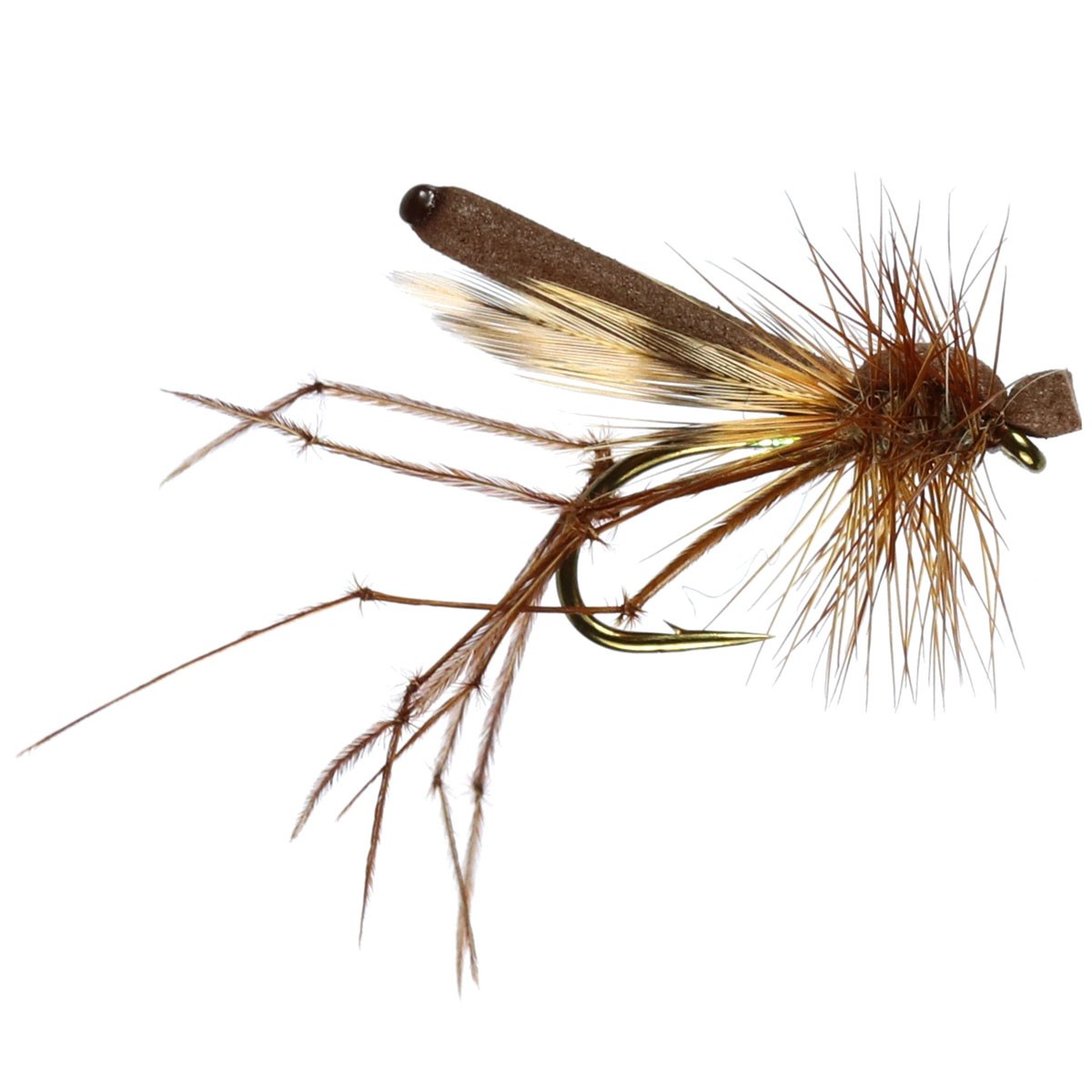Finally, with the brute force of winter finally subsiding, the weather is on the up – fingers crossed!
There is some great fly fishing to be had in March, and in this article, we will be going through what our 10 go-to flies are for this time of the year in Stillwater.

Temperatures average around 10 degrees at this time of year, so the water temperature is cool, but with high oxygen levels, this means that the trout are moving about and on the feed! Depending on what venue you fish, clarity may vary. Some fisheries have gin clear water, others have a cloudy appearance. The benefit of clear water fisheries is you can see the reaction of the fish to your fly, but if you don’t it doesn’t matter. Polarised glasses can offer the angler a big advantage in these situations by cutting out surface glare and allowing you to see into the water.
If your fishery of choice has cloudy lakes, don’t automatically think you need to put on a large, bulky fly as the fish can see the fly much better then we can.
Locating the trout
Since its March, new life is starting to grow and move about, so sometimes the trout hug the margins awaiting the eager nymphs that rise to the surface film. Don’t overlook this area close to the bank as the fish could be right by your feet.
Some trout still hold the depths of the water though so blind casting may come into play where you cast out your line to where you think they might be, and then retrieve in hope for a take.
Look out for any structures. Trout, especially big brownies like to cruise or lay under and fallen trees or bankside cover in search of food, or just because they feel safe, meaning you could always induce a take.
Below I will list my 10 go-to flies for fly fishing in March that have always worked for me. Some flies may work better than others, but overall these have produced great catches for me. My biggest tip would be, don’t get stuck to just one fly. Keep changing until you find the killer fly that they are after. See how the trout react, keep watching and monitoring it.
If they aren’t feeling the fly then don’t waste your time, chop and change!
Also, keep on the move, not just because your feet are starting to freeze, the trout too are moving around to find food. Keep fan casting and cover as much water as possible, spend around 10-15 minutes and if no luck then move on to the next spot.
10 go-to flies for March
Blue Flash Damsel
Now since the water temperature is nice and cool the trout are on the move. I always start or end with a blue flash damsel as it usually gets the job done. This fly has been voted one of the best Stillwater flies in many different catch record books. I’ve seen comments in the record books at certain fisheries saying that the fisherman had bagged up their quarry in the first few hours of fishing. The reason why I start or end with this fly is that it’s a great way to indicate what the fish are after. If the fish are switched on and wanting large flies, then you will know. I’ve had plenty of times where I’ve had to stop using this fly as I was getting so many chases and takes,- but it’s a nice problem to have!

How I fish the fly
When using the Blue Flash Damsel, the trout either want it one of two ways. A nice consistent figure of eight at varying speeds or a fast-jerky style retrieve. Once you cast the fly out, do nothing and let the fly sink to the depth the trout are feeding at. I count for about 6-15 seconds depending on what venue I am at and then I retrieve the fly. Most of the venues I fish aren’t crazily deep so I use a standard floating line with a rod lengths leader (The leader I’ve used for years is Drennan Sub Surface) but if the lakes you fish are deep then you can go for various sinking lines.
Hare’s Ear (or similar shaped shrimp patterns)
Since the cool temperature reduces the amount of fly and bug life in or around the water’s edge, Shrimp’s or scuds are a main source of food available to these trout. I never go fly fishing without a few of these flies. There are many different types. The image below is just a reference of the style I use. The trout go crazy for these, they swirl and glide through the water when they see these flies. I have picked up a few good fish from this pattern. I recommend having a range of colours, bright coloured scuds are great but it’s nice to have a varied selection meaning you can find exactly what they are looking for.
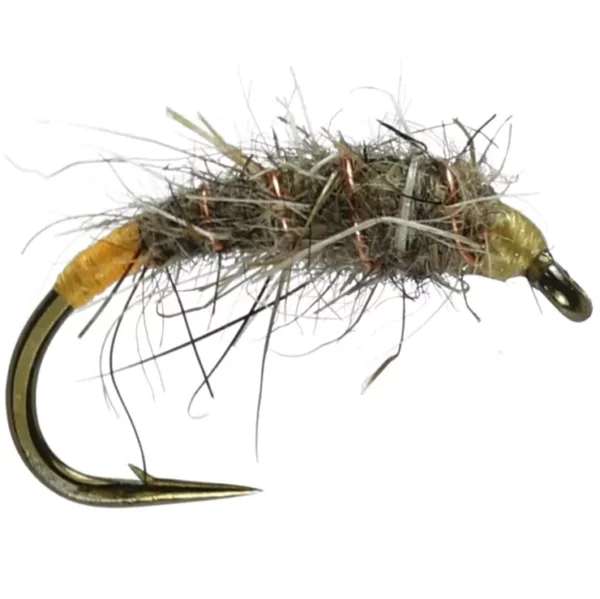
How I fish the fly
You can get weighted versions of these flies or similar. Weighted is needed sometimes because to fish this fly you either stalk the margins and look for the cruising trout, meaning you need to get it in front of its face as soon as possible, or you fish really deep in the centre of the stillwater. Either method will catch you fish, it just comes down to preference. I love to stalk the trout in the margins as it’s the best feeling when they hit your fly. The retrieve is really easy. I strip these flies in, use the method, strip, strip, pause and then repeat, this usually picks a few fish up. I use the same floating line with all my flies.
Orange Blob
This fly, the orange blob is used by many Stillwater fisherman. This can be a killer on its day. The trout go after the fly like it’s a small blob of candy floss. It’s not one for the traditionalist but certainly gets the job done. You can get them in a massive range of colours, from extremely bright pink to dark brown colours.
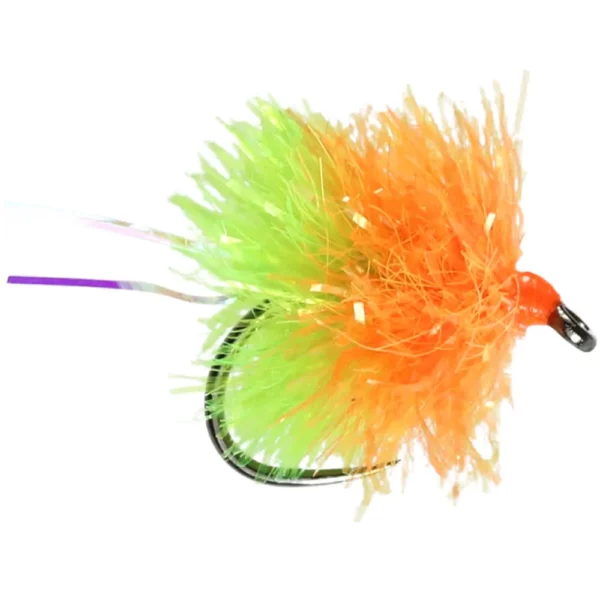
How I fish the fly
These flies are fantastic if fish are sitting around 3-5ft deep. If you use a bright colour blob than you need to cast it out to where you see a trout or to where you think they are and then let it sink to the desired depth, and then strip the fly in fast. The bright colours and fast movement really engage the trout. If you choose to use a dark colour Blob then use a slower retrieve at the same depth.
Buzzers
New life starts to happen in March and nymphs start to become active. It’s always worth having some buzzers in your fly box because this is another main source of the trout diet. You can use these buzzers in any weather I’ve found, but a nice bright clear day reaps the best rewards.
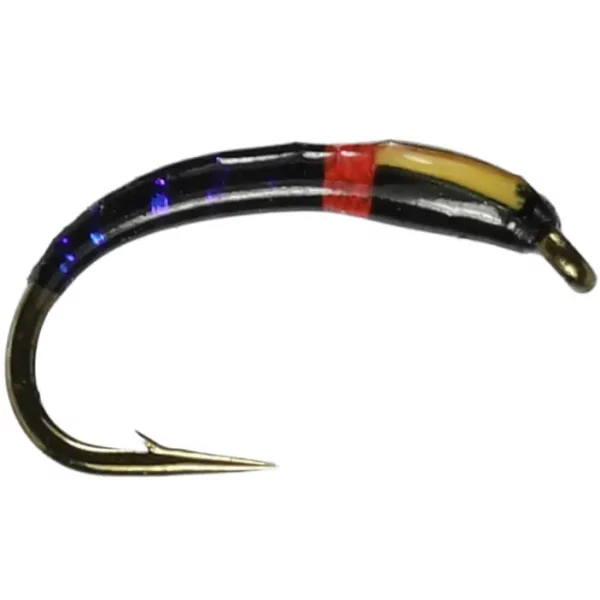
How I fish the fly
The best way I’ve found to fish these buzzers is a nice slow figure of eight retrieve. Do a nice long cast, retrieve in the figure of eight method and you should pick up a trout in a few casts. You can also fish these deep, near the bottom on the lake can get you good results. Don’t be afraid to try different colours as well.
Foam Daddy Long Legs
Now, you’re probably thinking no chance with a dry fly, but think again! Sometimes the early spring sun can bring on enough warmth to bring on a hatch. I know Daddy Long Legs are great in September onwards, but I’ve had great catches in March on this fly.
How I fish the fly
I only use this fly when I can either see a rise or some trout near the surface. Cast the daddy longs legs out and let it sit, pull your line tight so there is no slack between you and the fly, this means that if a trout takes your fly you won’t miss it, simply strike to the side reducing the chance of you pulling the fly from the trout’s mouth. You can strip the fly across the surface which creates a disturbance that the trout love, this is a very exciting way to catch trout!
Black Cat Bunny Leech
This fly is a streamer and is great to catch trout when other flies don’t work. Leeches are also a big part of the trout’s diet so a lot of the flies you use at this time of the year are trying to mimic the ones that are usually available to the trout yearly. These flies have a zonker strip on them which, when the rabbit fur is wet creates awesome movement.
How I fish the fly
When I use this fly, I use the same floating line and leader as I do with all my flies. The zonker strip creates a pulsating movement in the water so a slow, erratic retrieve is the best way to use these flies. You can get many different colours and sizes and I wouldn’t be surprised if you caught a nice Stillwater brownie on this fly.
Titanic Bug Black
This is a stalking fly fisherman’s bread and butter. I love these types of fly because as you can see, you have a nice weighted bead at the front and then lead wire wrapped as the body creating one very heavy fly. The marabou tail with flash switches the trout on and usually induces a take.

How I fish the fly
I fish this fly at a leader’s length, – usually for this fly, all you need is a bow and arrow cast since you are stalking the trout that are in the margins. Wait until you see the trout or where you think a trout could be cruising. You want to get this fly a few feet in front of its cruising path meaning it will get down to its level by the time it reaches it. Once it’s there jig the fly up and down, the tail will pulsate and the trout should take.
Humungous
This fly is another “attractor” pattern and can be lethal. This fly is like the blue flash damsel above,- if the trout want it then you can sometimes catch nearly every cast. Try and mix and match different colours as sometimes the trout are wanting something bright! The marabou tail is what makes this fly. The pulsating movement really gets the trout going.
How I fish the fly
This fly fishes really well if you can get a nice cast out to where the trout are, and then let it sink for around 10-15 seconds or until you know it’s at the trout’s level. Use a steady figure of eight retrieve or they may be wanting an erratic retrieve. Try different retrieve patterns until you find the one they like.
Leggy Blood Worm
Now this is one crazy looking fly, but it still gets good results. This represents the buzzer in its larval stage so it’s a key fly to have in your fishing armoury. Trout feed on these when they start to move around on the bottom of the lake.
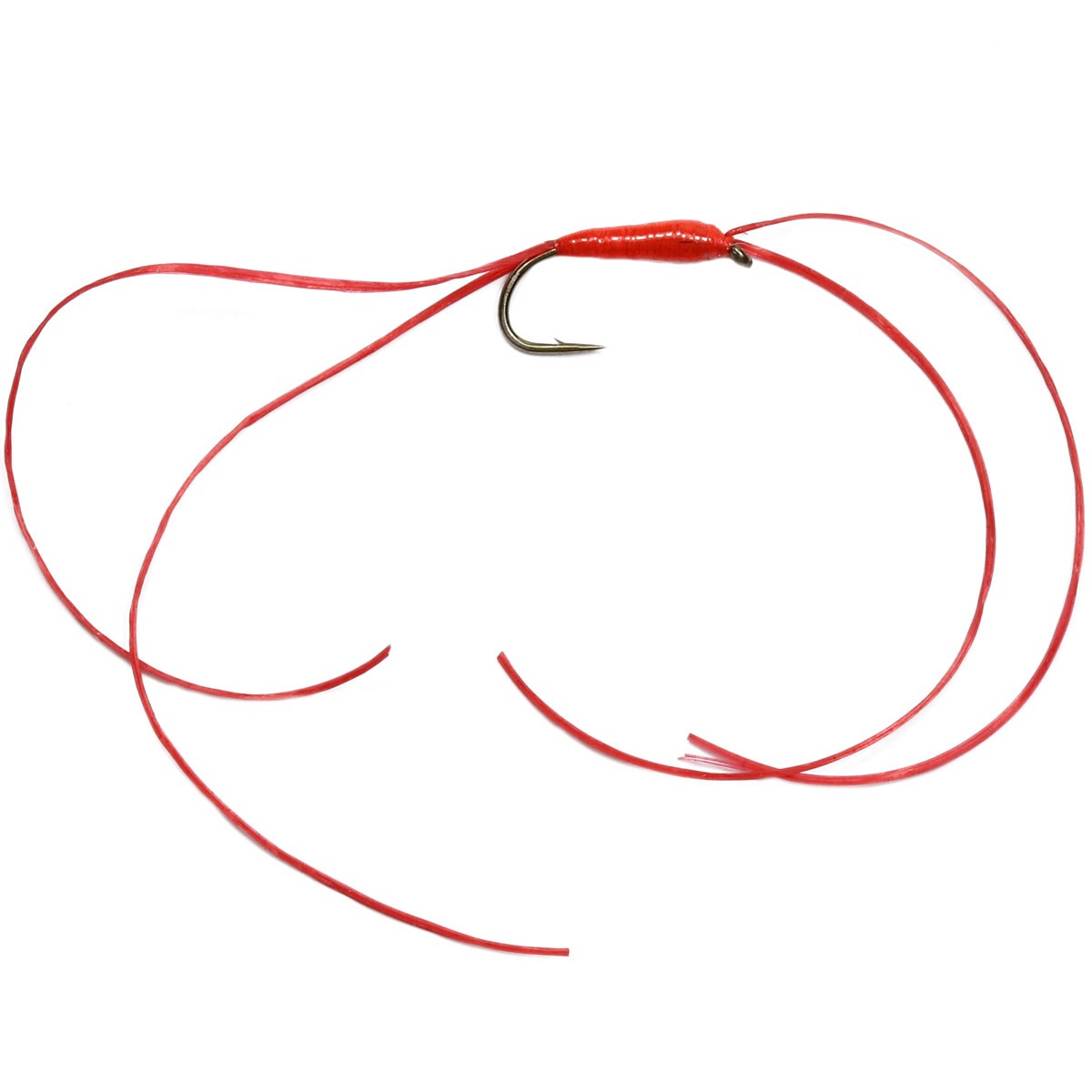
How I fish the fly
The trout feed on these at the bottom of the lake, so these need to be fished near or on the bed of the lake. You can fish them close in or out far. Just remember, let the fly sit on the bottom and retrieve the fly with a slow steady figure of eight, this imitates the worm moving exactly like the real thing.
Montana Nymph
This fly has caught me some great fish over the years. I have also had great success on a black and yellow, as well as a black and orange version. For some reason, the trout can’t resist them.
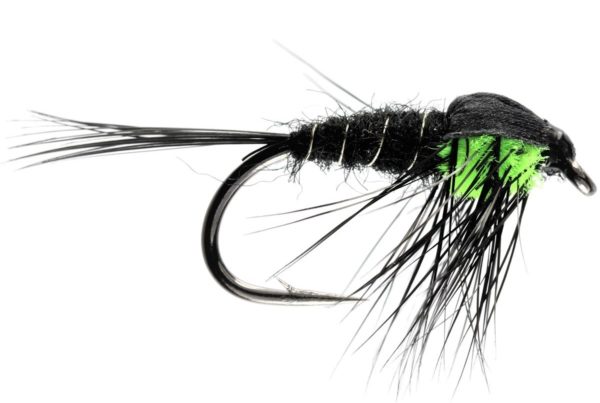
How I fish the fly
I fish these the same as any other nymph. Get a good cast out into the lake and retrieve with a steady figure of eight. The fluid movement of the nymph makes the trout go into a frenzy and they all want to hit this fly. Try different colours, as I said above, I have had great success on many different versions of these.
So, there you have it, my top 10 Stillwater flies for March. I can’t guarantee you catching fish,- but these will give you a very good shot at catching one. Just remember to keep moving and covering water. Chop and change to different flies, don’t just use one fly if it isn’t working. Now over to you, tight lines and go and catch some trout!
Click here to view our full range of trout flies!


